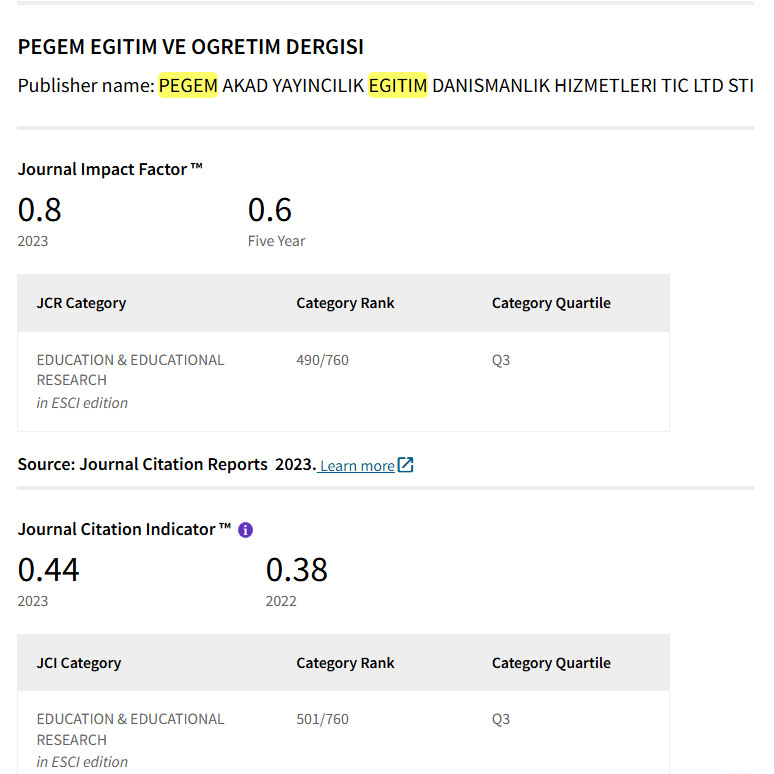Profile of Needs Analysis of Five-Tier Diagnostic Instrument Development for High School Chemistry Courses
DOI:
https://doi.org/10.47750/pegegog.14.02.17Keywords:
Diagnostic Assessment, Five-Tier, Chemistry LessonAbstract
This study aims to determine the need for a multitier diagnostic instrument to identify misconceptions and their causes, as well as multiple representation profiles.The data analysis technique used in this research is descriptive analysis technique. The subjects used in this study were several chemistry teachers in East Java totaling 67 teachers who were taken by random sampling. Data was collected through a questionnaire distributed using google forms media. The results of the analysis found that a diagnostic assessment on chemistry subjects was made up to the macroscopic, submicroscopic, and symbolic levels with a percentage of 93%, it was necessary to apply a diagnostic assessment on all chemistry learning topics with a percentage of 61%, a diagnostic assessment on chemistry subjects was required to be made on a multitier basis. level 5 with a percentage of 79%.
Downloads
References
Abidin, M., & Retnawati, H. (2019). A diagnosis of difficulties in answering questions of circle material on junior high school students. Jurnal Penelitian Dan Evaluasi Pendidikan, 23(2), 144–155. https://doi.org/10.21831/pep.v23i2.16454
Adadan, E., & Savasci, F. (2012). An analysis of 16-17-year-old students’ understanding of solution chemistry concepts using a two-tier diagnostic instrument. International Journal of Science Education, 34(4), 513–544. https://doi.org/10.1080/09500693.2011.636084
Anam, R. S., Widodo, A., Sopandi, W., & Wu, H. K. (2019). Developing a five-tier diagnostic test to identify students’ misconceptions in science: an example of the heat transfer concepts. Elementary Education Online, 18(3), 1014–1029. https://doi.org/10.17051/ilkonline.2019.609690
Bayuni, T. C., Sopandi, W., & Sujana, A. (2018). Identification misconception of primary school teacher education students in changes of matters using a five-tier diagnostic test. Journal of Physics: Conference Series, 1013(1). https://doi.org/10.1088/1742-6596/1013/1/012086
Chang, R., & Overby, J. (2011). General Chemistry: The Essential Concept. Mc Graw Hill.
Effendi, Muh. A. (2016). The Power of Good Corporate Governance: Teori dan Implementasi.
Firmanzah, D., & Sudibyo, E. (2021). PENSA E-JURNAL : PENDIDIKAN SAINS https://ejournal.unesa.ac.id/index.php/pensa/index IMPLEMENTASI ASESMEN DIAGNOSTIK DALAM PEMBELAJARAN IPA PADA MASA PANDEMI COVID-19 DI SMP/MTS WILAYAH MENGANTI, GRESIK. 9(2), 165–170. https://ejournal.unesa.ac.id/index.php/pensa/index
Gurel, D. K., Eryilmaz, A., & McDermott, L. C. (2015). A review and comparison of diagnostic instruments to identify students’ misconceptions in science. Eurasia Journal of Mathematics, Science and Technology Education, 11(5), 989–1008. https://doi.org/10.12973/eurasia.2015.1369a
Intan Permata, J., Sukestiyarno, Y., & Hindarto, N. (2017). Unnes Journal of Mathematics Education Research Analisis Representasi Matematis Ditinjau dari Kreativitas dalam Pembelajaran Cps dengan Asesmen Diagnostik Info Artikel. UJMER, 6(2), 233–241. http://journal.unnes.ac.id/sju/index.php/ujmer
Kirbulut, Z. D., & Geban, O. (2014). Using three-tier diagnostic test to assess students’ misconceptions of states of matter. Eurasia Journal of Mathematics, Science and Technology Education, 10(5), 509–521. https://doi.org/10.12973/eurasia.2014.1128a
Luqman, M., & Abbas, H. (2019). IDENTIFIKASI MISKONSEPSI MAHASISWA TADRIS FISIKA MENGGUNAKAN FOUR TIER DIAGNOSTIC TEST PADA MATA KULIAH KALKULUS II IDENTIFICATION STUDENTS’ PHYSICS EDUCATION MISCONCEPTIONS USING FOUR TIER DIAGNOSTIC TEST ON 2 ND CALCULUS COURSES (Vol. 4, Issue 1).
Mubarak, S., Susilaningsih, E., & Cahyono, E. (2016). PENGEMBANGAN TES DIAGNOSTIK THREE TIER MULTIPLE CHOICE UNTUK MENGIDENTIFIKASI MISKONSEPSI PESERTA DIDIK KELAS XI Info Artikel. http://journal.unnes.ac.id/sju/index.php/jise
Nyachwaya, J. M., & Wood, N. B. (2014). Evaluation of chemical representations in physical chemistry textbooks. Chemistry Education Research and Practice, 15(4), 720–728. https://doi.org/10.1039/c4rp00113c
Permatasari, M. B., Muchson, M., Hakimah, N., Rokhim, D. A., Herunata, H., & Yahmin, M. (2022). Identifikasi Miskonsepsi Materi Kesetimbangan Kimia pada Siswa SMA Menggunakan Tes Three Tier Berbasis Web. Jurnal Inovasi Pendidikan Kimia, 16(1), 1–7. https://doi.org/10.15294/jipk.v16i1.29407
Prihatni, Y., Kumaidi, ), Mundilarto, ), & Yogyakarta, U. N. (2016). PENGEMBANGAN INSTRUMEN DIAGNOSTIK KOGNITIF PADA MATA PELAJARAN IPA DI SMP 1). Jurnal Penelitian Dan Evaluasi Pendidikan, 20(1), 111. http://journal.uny.ac.id/index.php/jpep
Putra, A. S. U., Hamidah, I., & Nahadi. (2020). The development of five-tier diagnostic test to identify misconceptions and causes of students’ misconceptions in waves and optics materials. Journal of Physics: Conference Series, 1521(2). https://doi.org/10.1088/1742-6596/1521/2/022020
Rokhim, D. A., Syafruddin, A. B., & Widarti, H. R. (2020). Analysis of Need for Teaching Materials Based STEM-PjBL Assisted by Instructional Videos on Topic Voltaic Cells. Pedagogia : Jurnal Pendidikan, 9(2). https://doi.org/10.21070/pedagogia.v9i2.736
Romadhona, N., Qodriyah, L., Rokhim, D. A., Widarti, H. R., & Habiddin, H. (2020). IDENTIFIKASI MISKONSEPSI SISWA KELAS XI SMA NEGERI 4 MALANG PADA MATERI HIDROKARBON MENGGUNAKAN INSTRUMEN DIAGNOSTIK THREE TIER. https://www.researchgate.net/publication/343280207
Roy Asrori, M., Retno Widarti, H., & Deni Ainur, R. (2021). Chemistry in Education. CiE, 10(1). http://journal.unnes.ac.id/sju/index.php/chemined
Setiawan, D., & Jaelani, J. (2021). Five-Tier Diagnostic Test to Reveal Conceptual Understanding of Electrical Engineering Students. Berkala Ilmiah Pendidikan Fisika, 9(3), 326. https://doi.org/10.20527/bipf.v9i3.11190
Soeharto, Csapó, B., Sarimanah, E., Dewi, F. I., & Sabri, T. (2019). A review of students’ common misconceptions in science and their diagnostic assessment tools. Jurnal Pendidikan IPA Indonesia, 8(2), 247–266. https://doi.org/10.15294/jpii.v8i2.18649
Sugiyono. (2019). Metode Penelitian Kuantitatif, Kualitatif, dan R&D. Alphabet.
Üce, M., & Ceyhan, İ. (2019). Misconception in Chemistry Education and Practices to Eliminate Them: Literature Analysis. Journal of Education and Training Studies, 7(3), 202. https://doi.org/10.11114/jets.v7i3.3990
Widarti, H. R., Rokhim, D. A., & Syafruddin, A. B. (2020). The development of electrolysis cell teaching material based on stem-pjbl approach assisted by learning video: A need analysis. Jurnal Pendidikan IPA Indonesia, 9(3), 309–318. https://doi.org/10.15294/jpii.v9i3.25199
Yulianti, N., & Andriani, N. (2014). PENGEMBANGAN INSTRUMEN PENILAIAN PSIKOMOTORIK PADA POKOK BAHASAN SUHU DAN KALOR DI SMP.
Downloads
Published
How to Cite
Issue
Section
License
Copyright (c) 2023 Pegem Journal of Education and Instruction

This work is licensed under a Creative Commons Attribution-NonCommercial 4.0 International License.
Attribution — You must give appropriate credit, provide a link to the license, and indicate if changes were made. You may do so in any reasonable manner, but not in any way that suggests the licensor endorses you or your use.
NonCommercial — You may not use the material for commercial purposes.
No additional restrictions — You may not apply legal terms or technological measures that legally restrict others from doing anything the license permits.



